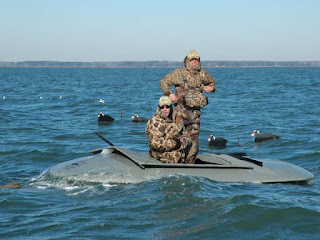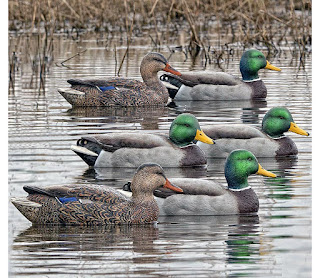Significant Approaches to Target Open-Water Ducks on Your Next Duck Hunting Vacations
Waterfowlers probably must have
observed a flock of diving ducks notice your decoys, stock against the wind,
fly on your decoy spread and then land several yards away on your duck hunting
vacations. Waterfowlers often find it difficult to get the ducks naturally
feed, hang out and feel safe in the open water to fly close to the shorelines or
an island.
And after watching flock after
flock of ducks land short or go round the edge of your blocks, waterfowlers desire
that they could be right there with them. Through adapting and mastering the right
tactics and gears, anglers can hunt diving ducks on the open water of flowages,
lakes and rivers. Know how!
Explore the Beneficial
Approaches to Target Open-Water Ducks on Your Next Duck Hunting Vacations:
- Stay Close to the Ducks:
Anglers must have no natural cover while you are a
half-mile away from shore. While hunting ducks through boats or boat blinds might
work wonders at times, but on the waters having many islands or bogs boats obtrude
on several lakes. And although nearly all the diver ducks are not as confident the
as late-season mallard ducks, they flicker from the abnormal scenes
particularly if they have been shot at.
Layout boats are
very beneficial to use and its specialized low-profile crafts completely eliminates
your outline and allow you lie amongst your duck decoys. Logistics and gears
are the primary challenges in the layout hunting. You require a big boat for shipping
waterfowlers, duck decoys and the layout boat.
- Correct Duck Decoy Gears:
On your Port O’ Connor duck hunting
vacations anglers can make use of rigged decoys, as the pre-rigged
multiple-decoy lines save a massive amount of time and efforts. Discover the
depth of the water that you plan to hunt and leave adequate line amid your
weight and the first duck decoy on the line.
Any big duck
decoy weight can adequately anchor your mother lines, but if you are hunting in
rocky or snag-filled waters then, traditional window sashes works the best.
They are very heavy, but waterfowlers can drag them on obstacles. Set up your
lines so that you can ship as many duck decoys as your boat can safely pull.
You would require at least four dozen blocks, which are being strung on four
lines.
Accumulate your
pre-rigged lengthy lines along the rails and deck of your boat, or coil them
into large lawn bags. Ensure that the decoys and mother lines do not intertwine.
It doesn’t really matter that how you set the lines, if you have left adequate
space between your boat and duck decoy strings. Set your decoys properly so that
the lines end downwind and all duck decoys are in the range of the layout boat.
Take your boat
upwind of layout and then float or motor along with the wind as the other waterfowlers
throw the anchor and duck decoys overboard individually, creating a straight
line. As you throw the last decoy in your string, pull the line to its suitable
position. Keep the string tight and then plunge the downwind anchor. Begin the interior
line at or a little upwind of the boat and then reel successive strings
downwind one yard or two. This will help the waterfowlers to break up the
blocky look of straight lines and have a great hunt.
- Positioning Hunters:
Once your spread is ready, get on the layout boat.
Motor very slowly to one side of the boat from downwind so that hunters can
control their drift in a better way and then hold the boat in one place so that
you can step into the layout. Then hold your unloaded shotgun and shells. Once
you are ready, your tender-craft operator will become the duck hunt supervisor
and will observe the shooter from a little distance (few 100 yards). When you
shoot a duck, your tender-craft operator draws anchor and motors towards the
downwind of the decoy spread. It is quite easy to watch the white bellies of
dead diving ducks moving up and down in the waves.
That is why while you are on
duck
hunting vacations in Port O’ Connor it is better to make use of the two-way
radios so that you can interact with the boat operator where your duck is and either
it is dead or diving. Make use of a big fishing net to recover the dead ducks. It
is far better to figure out the areas wherein the ducks feed, hang out or operate
to and from the roosting and feeding areas. Through doing this, hunters can seize
ducks which are moving naturally and in search for a company.
- The Caveats:
The open-water waterfowling
rules vary from one state to another or water to water. Obtain a firm hold on
what is legal in the area you are planning to go on the Port O’ Connor duck hunting
adventure. Diver ducks dive, which means if your shot fails to kill them in
the air then, they repeatedly hit the water and commence swimming and diving to
run away. And unless they are fatally injured or have broken legs, they are
pretty good at escaping from the hunters. Do not give them a single chance.
If the waterfowler
shoot a diving duck and the duck pops its head up as it hits the water then,
shoot the duck again right away. If the duck starts diving then, chase the duck
until you can safely and legally end it. Just stay safe above everything else, do
not overload your craft and wear the life jacket always. If the wind or weather
appears to be bothersome then, do not go out and wait until the weather conditions
get right.
Therefore, put into action the
above explained approaches to rightly target the open-water ducks on your upcoming
duck hunting
adventures in Port O’ Connor.








Comments
Post a Comment